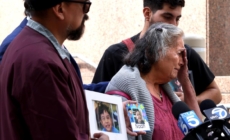-
Why a Chef in Brazil Couldn’t Stomach a Menu Request for a Prince’s Event - 12 mins ago
-
Map reveals where Trump plans to monitor California, New Jersey elections - 26 mins ago
-
Opinion | The Corruption Behind Trump’s East Wing Demolition - 57 mins ago
-
Detroit Pistons Celebrate Historic News After First Win - about 1 hour ago
-
Dodgers Only Have Themselves to Blame for Awful Bullpen Performances - 2 hours ago
-
Timothy Mellon Is Donor Who Gave $130 Million to Pay Troops During Shutdown - 2 hours ago
-
Commentary: As Trump blows up supposed narco boats, he uses an old, corrupt playbook on Latin America - 2 hours ago
-
Toddler’s Reaction To Mom’s Accidental Home Birth Captured on Camera - 2 hours ago
-
‘It’s Got to Be an Inside Job’: Jewelry Thieves Weigh In on Louvre Heist - 2 hours ago
-
Drugs, crime and homelessness plague MacArthur Park. Can a fence rescue it? - 3 hours ago
First West Nile virus death confirmed in L.A. County, as studies show drought may increase risk
The first recorded death from West Nile virus this year in L.A. County was confirmed Friday by the Los Angeles County Department of Public Health.
The individual, whose details have been kept anonymous, was hospitalized in the San Fernando Valley for neurological illness caused by the mosquito-borne virus. In Southern California, October is the middle of mosquito season.
Across Los Angeles County, 14 West Nile virus infections have been documented in 2025; half have been in the San Fernando Valley.
L.A. has had an average of 58 West Nile infections per year since 2020, with an average of one death per year, according to data from the Los Angeles County Department of Public Health.
West Nile virus affects around 2,000 Americans a year, according to the U.S. Centers for Disease Control and Prevention. Viral infection can a number of symptoms, with mild illness symptoms consisting of fever, headache, body aches, vomiting, rash or diarrhea, the CDC says.
A more severe and concerning case can cause neck stiffness, stupor, disorientation, tremors, convulsions, muscle weakness, vision loss, numbness, or paralysis. Officials warn that the effects of severe illness could be permanent or result in death.
In some cases, infection does not cause symptoms.
The California Public Health Department notes that there are a number of species within the Culex mosquito genus, which is a primary carrier of the virus, found throughout Los Angeles County.
The San Fernando Valley area recently suffered from water outages and has, over the last 12 months, consistently experienced below-average rainfall and drought conditions.
In a 2025 study from the National Institutes of Health, research showed that droughts raised risk factors for West Nile virus. Data from more than 50,000 traps revealed that while drought conditions reduced overall mosquito populations and standing bodies of water, it consolidated the infected mosquitos and birds, which also carry the disease, around limited water sources. The result is faster transmission rate among the smaller populations, which go on to infect humans. In the San Fernando Valley, where drought conditions are expect to continue through a dry La Niña season, the reduced water sources may lead to higher infection rates.
To avoid contracting West Nile virus, the CDC recommends reducing outside activities during the daytime, when mosquitos are most active. Officials also say that emptying or replacing containers of standing water (where mosquitos tend to breed), installing window screens, and wearing protective skin coverings or using insect repellent when outside can also reduce exposure.
Source link






















